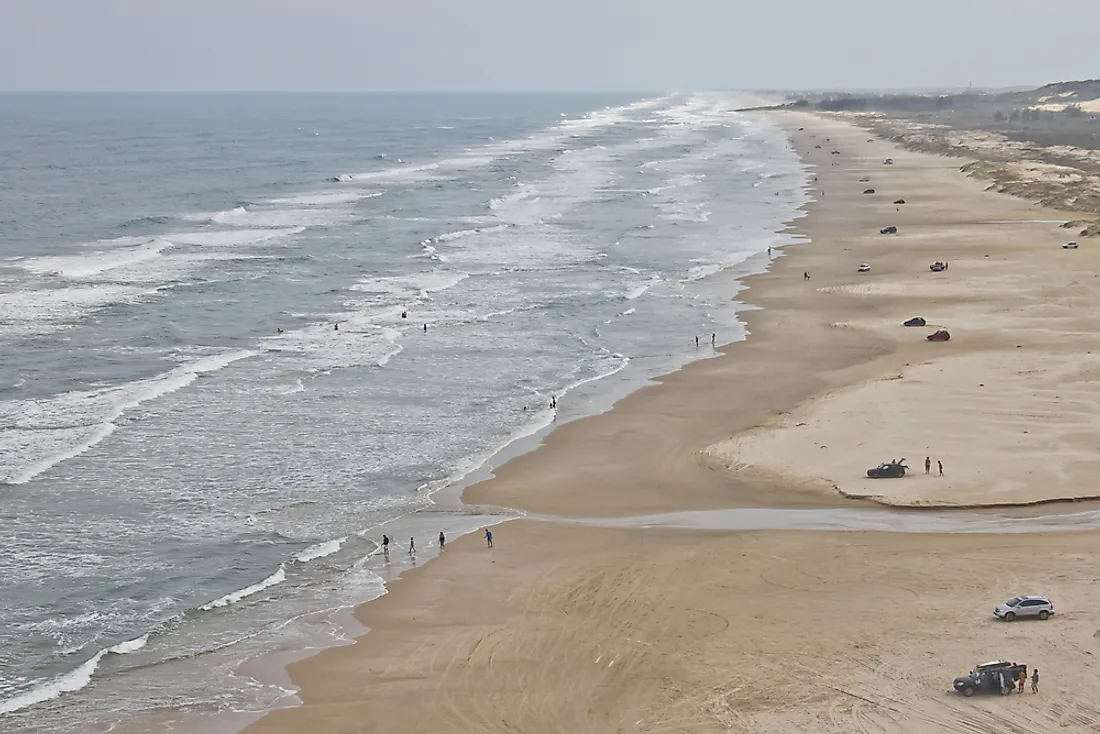Living On Cliffs: The Thrilling Dangers of A Chinese Village
| Top 10 Best Treks In The World For Adventurous Travellers To Discover | |
| Amazing Salt Island Floating In The Heart of Dead Sea | |
| Top 10 Longest Beaches in the World |
Locate in the north part of Henan Province, Guoliang Village is named after a fugitive riser called Guoliang. In the late Eastern Han Dynasty (25 ~ 220), the people suffered from destitution due to the natural disasters and the exploitation of the landlord and feudal official. In order to resist the oppression and pursue a better life, Guoliang, the son of a farmer, led a group of famine victims to rise in revolt. He had fought an overwhelming imperial force to a standstill utilizing the extreme terrain. Then, they transferred to a tiny village which is named as Guoliang Village by the later generations to memorize Guoliang.
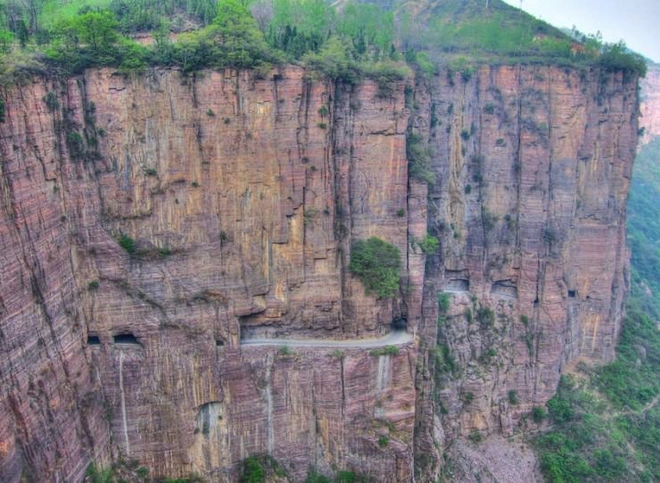 |
| Photo: Pandotrip |
Nowadays, Guoliang Village attracted large amounts of tourists with its arresting mountain ridges, featured stone houses, dangerous cliffs etc. The world-famous Guoliang Tunnel is praised as the Ninth Manmade Wonders by a film studio in Japan. The tourist also referred Guoliang Village as the Pearl Inlaid in Taihang Mountains. Attracted by awe-inspiring scenery, astonishing road and characteristic landform and quaint local customs, over 40 films and teleplays have been shot in Guoliang Village, including hot Chinese films Hands and Bell of Purity Temple . Therefore, Guoliang Village is also nicknamed as the No.1 Chinese Movies & TV Village. Many art academies and photographic associations also select Guoliang Village as a painting and photographing site.
History
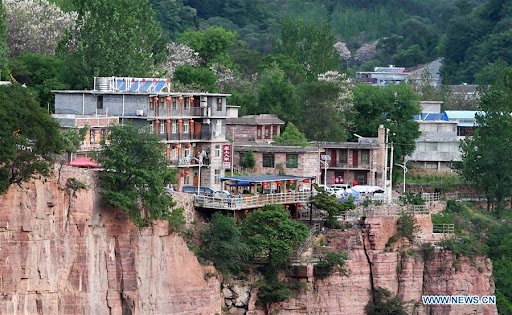 |
| Photo: China news |
It is said that to pay for the tools to carve the road, the villagers of Guoliang Village sacrificed a lot and even sold their animals and other necessities of life. What they probably didn’t realize was that the government would later think that this was a prime tourist attraction in central China. When the borders were opened for foreign travel in the last decade, foreigners started to find it and post pictures about it. Even a few years ago, it was a difficult place for foreigners to find and reach, but now the village is getting famous. Hotels have opened in the village, and bridges and walkways have been built for the tourists so that they can walk around in the area. Foreigners say that the hiking and scenery is excellent and there are lots of stairs to climb around on.
In the summer of 2011, there was a dispute between the villagers and officials about access and payment. Access to the village was restricted to foreigners, but some tourists still got in. So if you are planning a trip there, check the internet for the latest news.
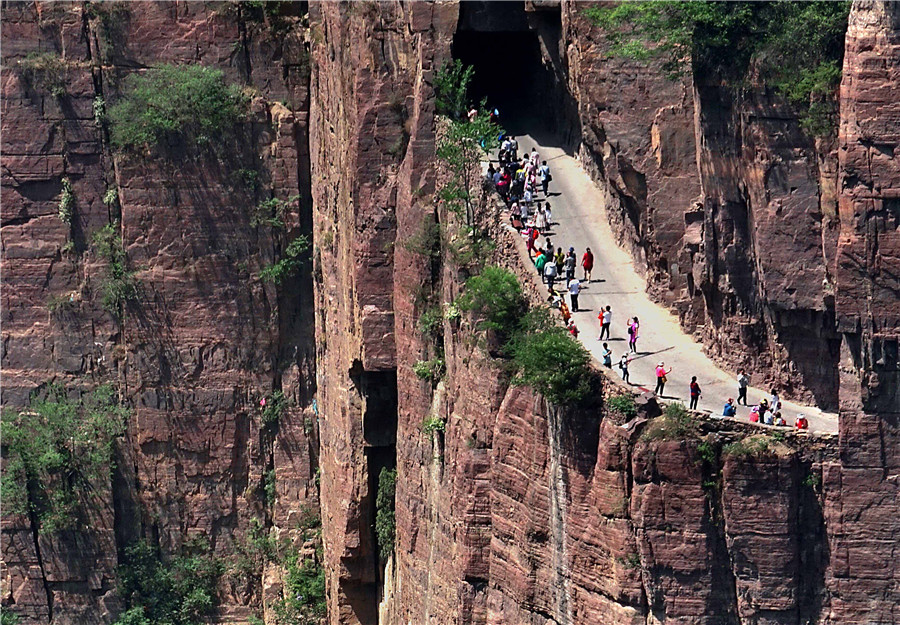 |
| Tourists visit a section of the road that links to Guoliang village in Huixian county, Henan province. The road winds through the Taihang Mountains. LI AN/XINHUA |
Highlights of Guoliang Village
Guoliang Tunnel - Mannually-constructed Road Hanging on the Cliff
 |
| Photo: PandoTrip |
Guoliang Tunnel is a road linking Guoliang Village to the outside. Before it was constructed, a crude and dangerous ladder made by stones is the only exit for the villagers. In 1972, the initial development began to take place in China and "building roads is a premise of amassing a fortune" became a common ground spreading everywhere. Guided by a man called Shen Mingxin, thirteen villagers raised fund by selling goats and crops, and bought some hand-tools. Without one electric equipment or large machinery, the villagers carved a 1300-meter-long Guoling Tunnel along the side of and through the mountain. At the most difficult stage, the tunnel progressed at a rate of one meter every three days. After 5 years of hardworking, this road was open to traffic in 1st May 1977. For its steepness, Guoliang Tunnel is called one of the Top Ten Dangerous Roads in the World and one of the Top Eighteen Peculiar Roads in the World.
The wall of Guoliang Tunnel is in a diversity of shapes, some are neat and flat, some are unevenness. Guoliang Tunnel runs zigzag up the hill, and driving on the roads you will feel the flickering lights. Overlooking Guoliang Tunnel from the confronted cliffs, you will have another feeling. As if the cliff was shot by machine guns, you can figure out the "wound" left. Outside the cave is many beautiful net-like waterfalls.
Amazing Nature - Grand Gorge with Red Rocks
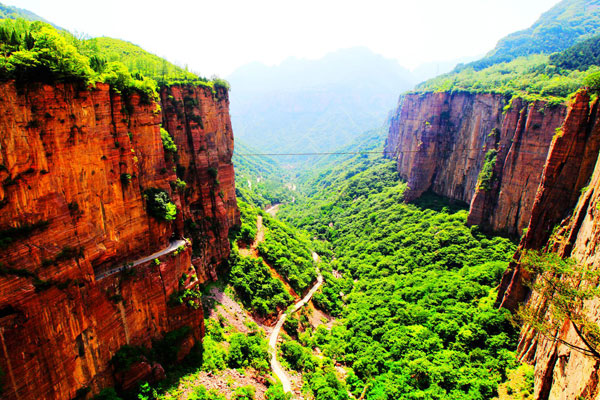 |
| Photo: China Discovery |
The Grand Gorge with Red Rocks originated from Guoliang Village and winded to the Wangmang Mountain in Shanxi Province. It seems being cut by a sharp axe and shows a unique kind of landscape of beautiful red rocks, waterfalls and green plants. Looking the north side of this gorge, you can see incredible Guoliang Tunnel through the rocks and its 36 windows. In the south side, you can find some houses and some sturdy elm grown in the cliffs. There is a waterfall pouring from the cliff in to the small lake lying in the bottom of the gorge. In the winter, the flowing waterfall became a large ice block hanging on the cliff. As the spring comes, the ice blocks crack and fall into the icy lake, leaving sonic booms, just magnificent and thrilling.
There are many natural caves scattered in the gorge, among them Bailong Cave is open to public. With stalactites in various shapes to admire, you can have a peaceful but interesting experience. For the cave is rather narrow and dark, you need to take good care of yourself and visiting Bailong Cave with a waterproof torch or head lamp will be helpful. The extra admission for Bailong Cave is 20 RMB per person.
Sky Ladder - Old Dangeours Road to Guliang Village
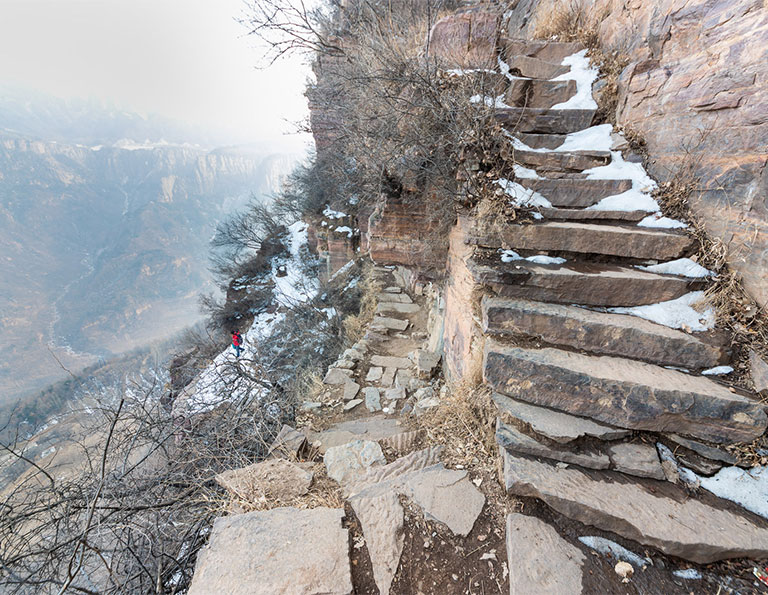 |
| Photo: China Discovery |
A saying about Guoliang Village goes like that you can't get to Guoliang Village without passing by Guoliang Tunnel and you never understand Guoliang Village without knowing the Sky Ladder. Sky Ladder is one long stone ladder with a history of more than 600 years, made up of scruffy rocks and the stone pit on the cliffs. It acted as the only road to leave Guoliang Village until Guoliang Tunnel was constructed. The hardship of climbing this ladder hinders the communication between Guoliang Village and the outside world, so people call it Sky Ladder. Sky Ladder once symbolizing poverty and closeness tell the past story of Guoliang Village.
At the top of the Sky Ladder, you can enjoy the most splendid sunrise in Guoliang Village. Around 5 o'clock in the moring, the clouds colored the Taihang Mountains to red. As sun rises from the horizon, the day breaks and the view at your sight became breathtaking. Far from the hustle and bustle of the modern city, you may doubt whether you are in a fictitious land of peace.
Stone Villages - Village Hidden in the Mountains
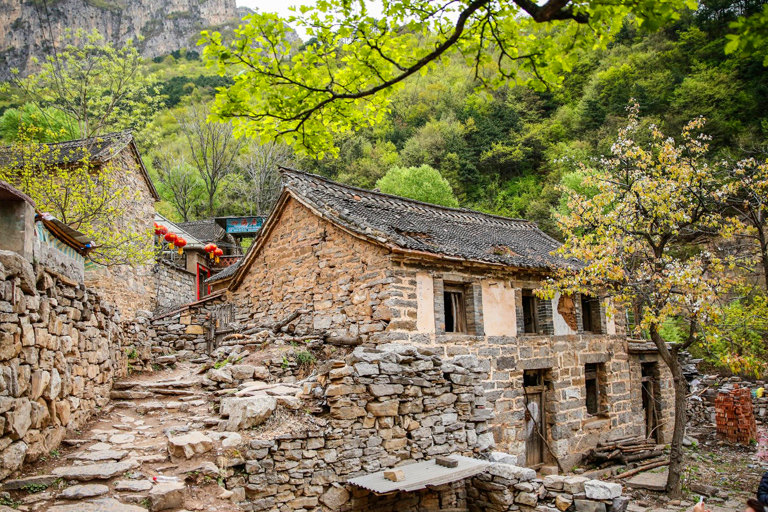 |
| Photo: China Discovery |
At the end of Guoliang Tunnel is Stone Village (also called Guoliang Village) surrounded by mountains, just peaceful and snug. An old willow standing at the entrance resembles an old gatekeeper. As a Film Village, Guoliang Village has a lot to explore. Cyan walls, black tiles and wood doors, quite different from the armored concrete in the city, will catch your eyes when you enter this small village. What you can see most in the residents' village is stone. The antique houses, yard walls, chicken pens and pigsty are all made by stones with irregular shapes. For the local people, especially in ancient time, stone is everything. Till now, you can also see numerous stone tools including mills, stone bowls, stone chopsticks, stone ax, stone hoes and so on.
Location & Transportation
Where is Guoliang Village
Guoliang Village is located in the Wanxianshan Scenic Area, about 54 km to northwest Huixian City, 82 km to Xinxiang City and 172 km to Zhengzhou City.
How to Get to Guoliang Village
By Train: There is a high-speed train in every one hour from Zhengzhou to Xinxiang, and you reach to Xinxiang Railway Station within 30 minutes. With several minutes' walk, you can arrive at Xinxiang Bus Station in which coach is available to Huixian City. Then you can transfer to Guoliang Village.
By Coach: Daily coaches departing from Zhengzhou or Xinxiang to Huixian are both enough. It takes 2 hours from Zhengzhou and 30 minutes from Xinxiang. As you get to Huixian Bus Station, you have to take another coach to Guoliang Village after going through the Guoliang Tunnel. The coaches to Guoliang Village are very limited.
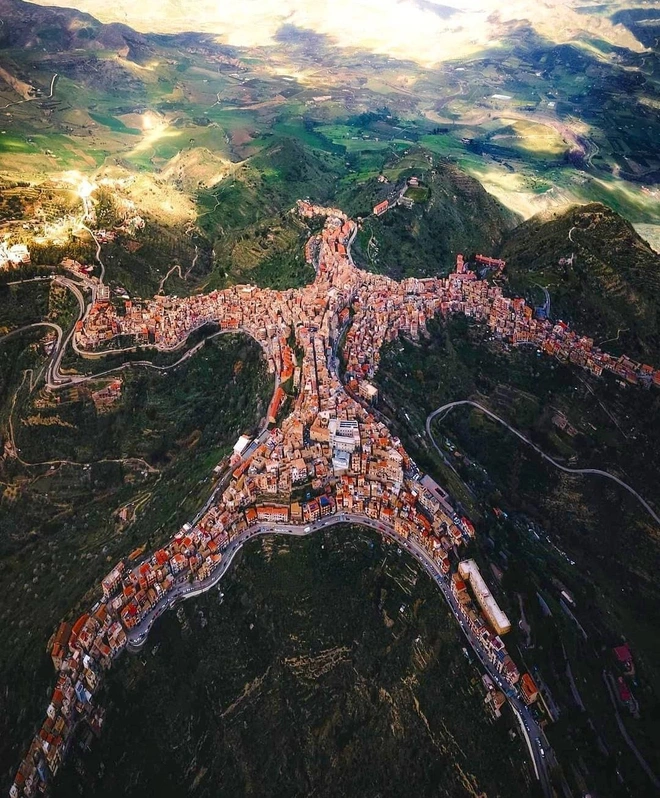 | Centuripe: The Sicily Village That Has The Weirdest Shape In The World There is a small village nestled in Sicily, Italy, which has the weirdest shape that both looks like a human chilling out and a starfish ... |
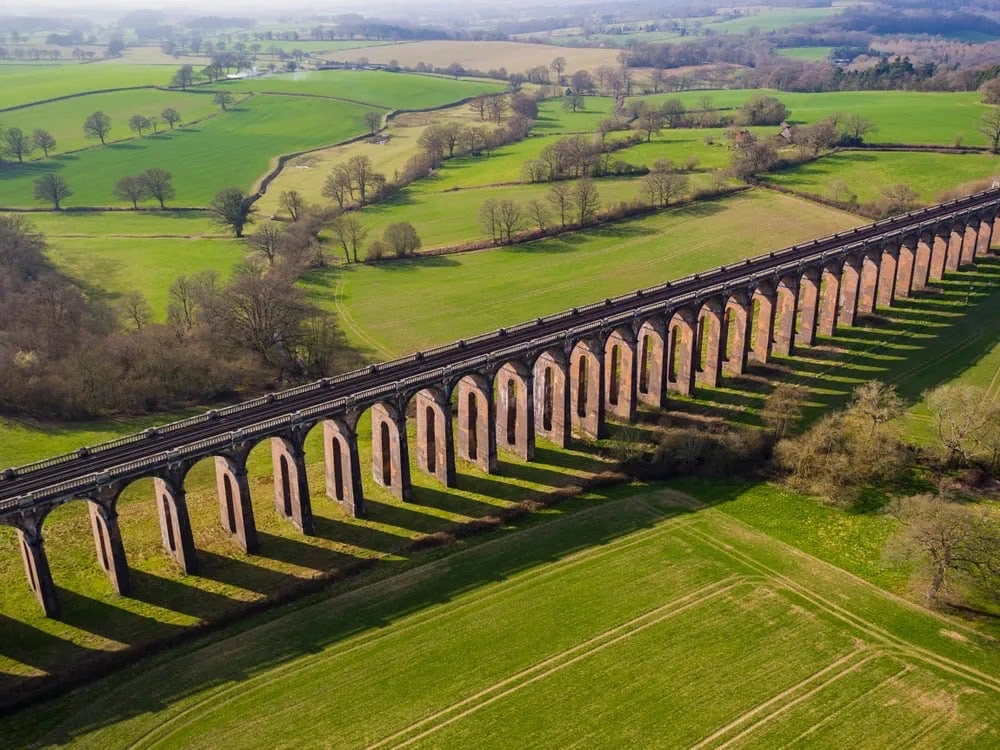 | Ouse Valley Viaduct: The Aesthetically Beautiful Spot Nestled in The Serene West Sussex Hills Located not far from the village of Cuckfield, the magnificent marvel of the Victorian Railway Age sits almost serenely in the beautiful hills of the ... |
 | Gorgeous Palaces Around The World For Luxury Loving Travelers From Dolmabahçe Palace to The Winter Palace, this is the most gorgeous and luxurious palaces from all around the world for you to add into ... |
Recommended
 World
World
Pakistan NCRC report explores emerging child rights issues
 World
World
"India has right to defend herself against terror," says German Foreign Minister, endorses Op Sindoor
 World
World
‘We stand with India’: Japan, UAE back New Delhi over its global outreach against terror
 World
World
'Action Was Entirely Justifiable': Former US NSA John Bolton Backs India's Right After Pahalgam Attack
Popular article
 World
World
Nifty, Sensex jumped more than 2% in opening as India-Pakistan tensions ease
 World
World
Easing of US-China Tariffs: Markets React Positively, Experts Remain Cautious
 World
World
India strikes back at terrorists with Operation Sindoor
 World
World



